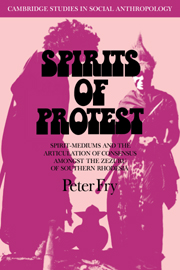 Spirits of Protest
Spirits of Protest Book contents
- Frontmatter
- Contents
- Acknowledgements
- Conventions
- Introduction
- 1 The secular background
- 2 Magico-religious beliefs – the moral significance of explanation
- 3 The sociology of spirit-mediumship
- 4 Zezuru flexibility and Korekore rigidity
- 5 Spirit-mediums in ritual action
- 6 Spirit-mediums and missionaries
- Notes
- Bibliography
- Index
6 - Spirit-mediums and missionaries
Published online by Cambridge University Press: 08 March 2010
- Frontmatter
- Contents
- Acknowledgements
- Conventions
- Introduction
- 1 The secular background
- 2 Magico-religious beliefs – the moral significance of explanation
- 3 The sociology of spirit-mediumship
- 4 Zezuru flexibility and Korekore rigidity
- 5 Spirit-mediums in ritual action
- 6 Spirit-mediums and missionaries
- Notes
- Bibliography
- Index
Summary
This book has been concerned with the sociology of spirit-mediumship at various levels of social structure ranging from the role of low-level mediums in village politics through the internal power politics of high-level mediums to their role in the Shona Rebellion of 1896–7.
However, while the spirit-mediums of Chiota were engaged in the internal politics of the villages and the wider community, they were also involved in the conflict between black and white that dominated all Southern Rhodesia. Structurally opposed to Christianity and symbolic of African tradition, the spirit-mediums proliferated in Chiota Tribal Trust Land as a spontaneous religious reaction to a situation of head-on conflict between black and white nationalisms.
The development of African protest in Southern Rhodesia
Six years after the arrival of the British South Africa Company in Southern Rhodesia in 1890, first the Ndebele and then the Shona of central Mashonaland rose up in rebellion against the white settlers. Both the rebellions were inspired by religious leaders, in the case of the Ndebele by the Karanga Mwari cult and in the case of the Shona by certain of their spirit-mediums.
Ranger's account of the Shona Rebellion makes it clear that it was a response to a series of grave deprivations. The Shona had suffered from drought, an attack of rinderpest which had decimated their herds of cattle and also a plague of locusts which had attacked their crops. Furthermore they had lost their political autonomy to the British South Africa Company which had set up an administration and imposed a Hut Tax in 1893.
- Type
- Chapter
- Information
- Spirits of ProtestSpirit-Mediums and the Articulation of Consensus among the Zezuru of Southern Rhodesia (Zimbabwe), pp. 107 - 123Publisher: Cambridge University PressPrint publication year: 1976
